The Radeon R9 280X Review: Feat. Asus & XFX - Meet The Radeon 200 Series
by Ryan Smith on October 8, 2013 12:01 AM ESTCompute
Jumping into compute, as with our synthetic benchmarks we aren’t expecting too much new here. Outside of DirectCompute GK104 is generally a poor compute GPU, which makes everything very easy for the Tahiti based 280X. At the same time compute is still a secondary function for these products, so while important the price cuts that go with the 280X are not quite as meaningful here.
As always we'll start with our DirectCompute game example, Civilization V, which uses DirectCompute to decompress textures on the fly. Civ V includes a sub-benchmark that exclusively tests the speed of their texture decompression algorithm by repeatedly decompressing the textures required for one of the game’s leader scenes. While DirectCompute is used in many games, this is one of the only games with a benchmark that can isolate the use of DirectCompute and its resulting performance.
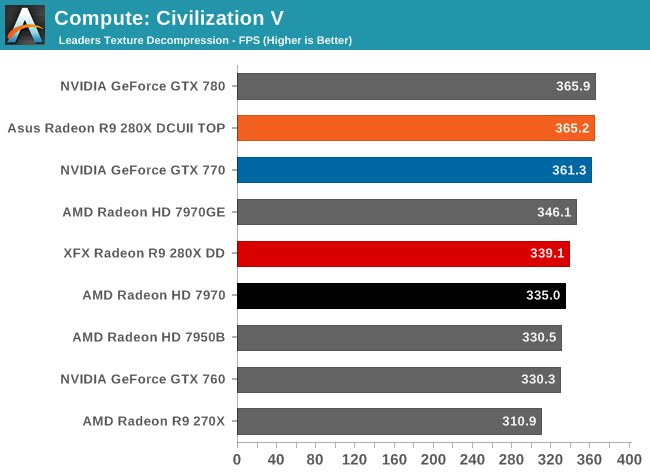
With Civilization V we’re finding that virtually every high-end GPU is running into the same bottleneck. We’ve reached the point where even GPU texture compression is CPU-bound.
Our next benchmark is LuxMark2.0, the official benchmark of SmallLuxGPU 2.0. SmallLuxGPU is an OpenCL accelerated ray tracer that is part of the larger LuxRender suite. Ray tracing has become a stronghold for GPUs in recent years as ray tracing maps well to GPU pipelines, allowing artists to render scenes much more quickly than with CPUs alone.
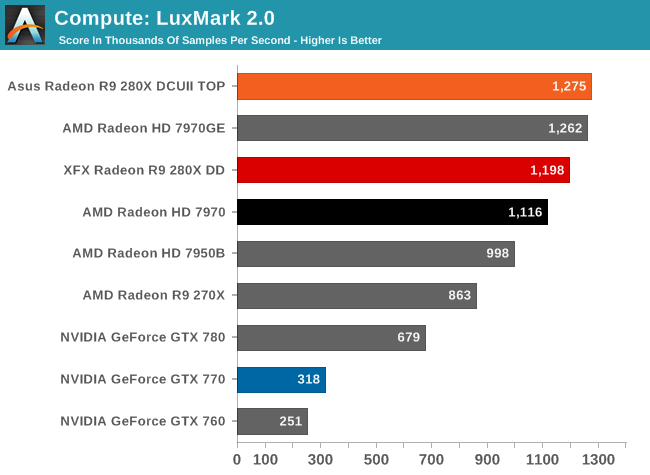
AMD simply rules the roost when it comes to LuxMark, so the only thing close to 280X here are other Tahiti parts.
Our 3rd compute benchmark is Sony Vegas Pro 12, an OpenGL and OpenCL video editing and authoring package. Vegas can use GPUs in a few different ways, the primary uses being to accelerate the video effects and compositing process itself, and in the video encoding step. With video encoding being increasingly offloaded to dedicated DSPs these days we’re focusing on the editing and compositing process, rendering to a low CPU overhead format (XDCAM EX). This specific test comes from Sony, and measures how long it takes to render a video.
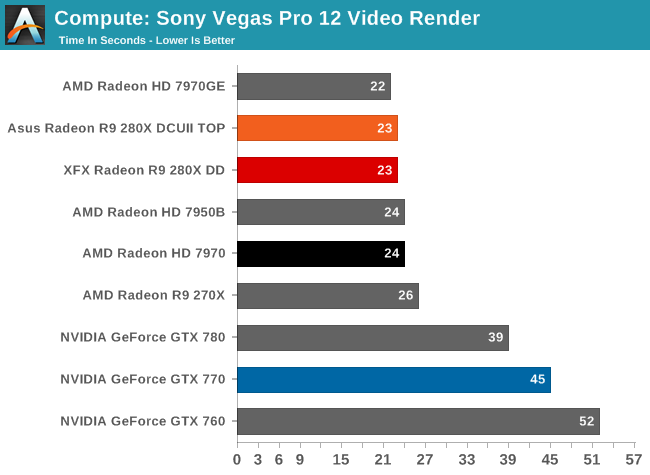
Again AMD’s strong compute performance shines through, with 280X easily topping the chart.
Our 4th benchmark set comes from CLBenchmark 1.1. CLBenchmark contains a number of subtests; we’re focusing on the most practical of them, the computer vision test and the fluid simulation test. The former being a useful proxy for computer imaging tasks where systems are required to parse images and identify features (e.g. humans), while fluid simulations are common in professional graphics work and games alike.
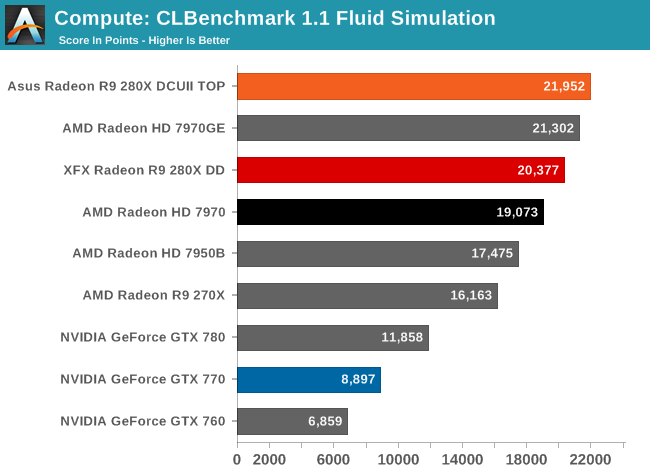
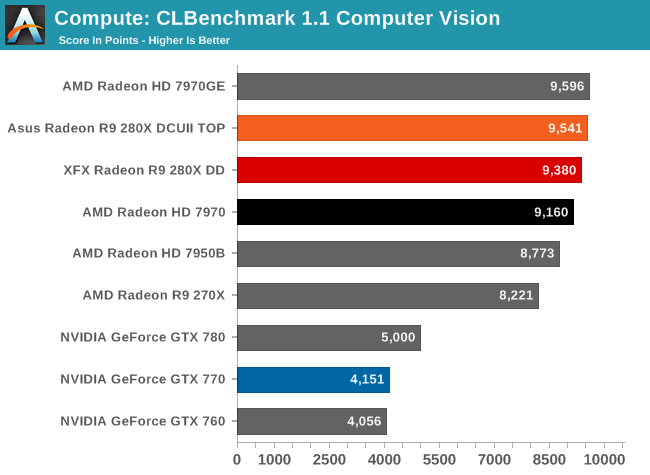
Despite the significant differences in these two workloads, in both cases 280X comes out easily on top.
Moving on, our 5th compute benchmark is FAHBench, the official Folding @ Home benchmark. Folding @ Home is the popular Stanford-backed research and distributed computing initiative that has work distributed to millions of volunteer computers over the internet, each of which is responsible for a tiny slice of a protein folding simulation. FAHBench can test both single precision and double precision floating point performance, with single precision being the most useful metric for most consumer cards due to their low double precision performance. Each precision has two modes, explicit and implicit, the difference being whether water atoms are included in the simulation, which adds quite a bit of work and overhead. This is another OpenCL test, as Folding @ Home has moved exclusively to OpenCL this year with FAHCore 17.

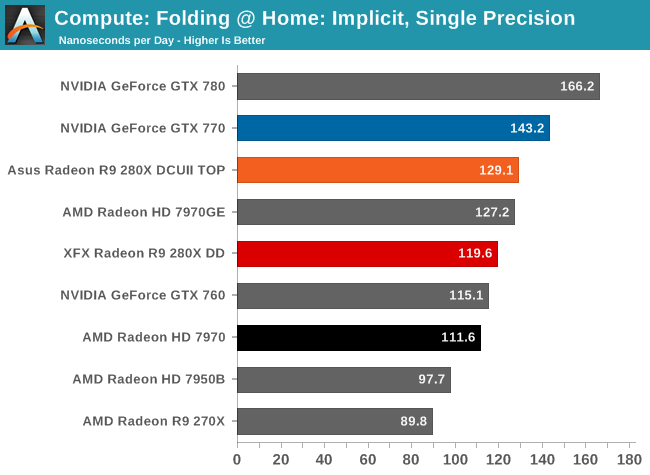

Depending on the mode and the precision, we can have wildly different results. The 280X does well in FP32 explicit, for example, but in implicit mode the 280X is now caught between the GTX 770 and GTX 760. But if we move to double precision then AMD’s native ¼ FP64 execution speed gives them a significant advantage here.
Wrapping things up, our final compute benchmark is an in-house project developed by our very own Dr. Ian Cutress. SystemCompute is our first C++ AMP benchmark, utilizing Microsoft’s simple C++ extensions to allow the easy use of GPU computing in C++ programs. SystemCompute in turn is a collection of benchmarks for several different fundamental compute algorithms, as described in this previous article, with the final score represented in points. DirectCompute is the compute backend for C++ AMP on Windows, so this forms our other DirectCompute test.
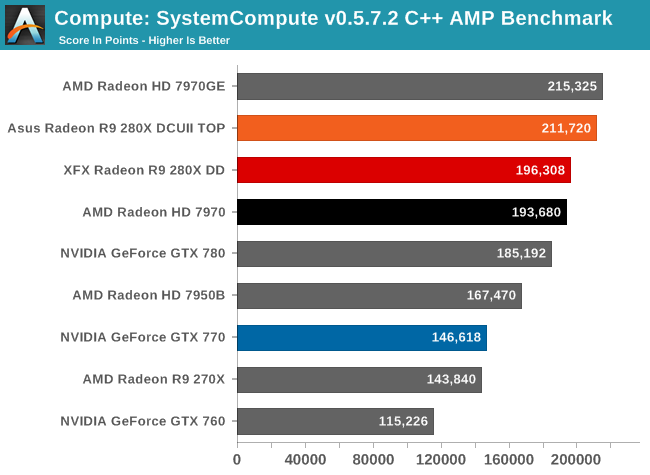
Although not by any means a blowout, yet again the 280X vies for the top here. When it comes to compute, the Tahiti based 280X is generally unopposed by anything in its price range.










151 Comments
View All Comments
nathanddrews - Tuesday, October 8, 2013 - link
GTX700 = GTX770, derp.Da W - Tuesday, October 8, 2013 - link
Sure. Just go to your job every day and work hard just to give free stuff at people.nathanddrews - Tuesday, October 8, 2013 - link
Who said anything about giving "free stuff at people"? I'm talking about competitive pricing - the NVIDIA lineup is overpriced.Mondozai - Tuesday, October 8, 2013 - link
Speaking of which, we could use an edit function ;)Mondozai - Tuesday, October 8, 2013 - link
Nah, they are more logical now. People are just bitching because their head hurts when re-adjusting.JPForums - Tuesday, October 8, 2013 - link
So, the 280X is a 7970(not quite)GHz edition that is not quite price competitive with overclocked 7970s that give you essentially the same thing.The 270X is a 7870 with a token boost clock and better memory bandwidth. Unfortunately it is priced $20 ($50 w/MIR) more expensive than the generally more powerful 7870XT.
The 260XT is a 7790 with a somewhat meaningful boost clock. Too bad it is priced closer to a 7850 than a 7790. Mail-in-Rebates only make the situation worse.
Well, ... , I'm underwhelmed.
7970 (OC) - $300 ($280 w/MIR)
http://www.newegg.com/Product/Product.aspx?Item=N8...
7870XT - $180 ($150 w/MIR)
http://www.newegg.com/Product/Product.aspx?Item=N8...
7850 - $145 ($125 w/MIR)
http://www.newegg.com/Product/Product.aspx?Item=N8...
7790 - $120 ($100 w/MIR)
http://www.newegg.com/Product/Product.aspx?Item=N8...
JPForums - Tuesday, October 8, 2013 - link
Note: The AMD news section seems to be penta-posting articles. Please remove this comment once corrected.noeldillabough - Tuesday, October 8, 2013 - link
I loved the 290x specs chart :0alfredska - Tuesday, October 8, 2013 - link
Ryan, you need a better editor -- or an editor, period. Here's the first four paragraphs of your "Final Words", cleaned up and less abrasive:Bringing this review to a close, the initial launch of the Radeon 200 series is something of a warm-up act. AMD’s Big Kahuna, the R9 290X, is not yet here and will be a story of its own. In the meantime, AMD has kicked off 2014 with the bulk of their graphics lineup.
As far as performance is concerned, the 200 series is more of a refresh of the existing Tahiti, Pitcairn, and Bonaire GPUs than a revolution. The performance is is only a few percent better on average. While I wouldn't call this a new coat of paint on the 7000 series, these products are still largely unchanged from those we’ve seen over the last two years.
Today’s launch represents a consolidation of products and a formalization of prices. The number of products based on the each GPUs has been cut down significantly; there’s now only 1 card per GPU as opposed to 2 or 3. AMD can lower the prices on existing products, redefining the high-end, enthusiast, and mainstream markets, as opposed to flogging cards based on the 7970 as sub-$300 enthusiast parts. Nearly two years in, these parts are hitting what should have been their introductory prices.
Today, there’s no getting around the fact that similar 7000 series products are going to be equal in price or cheaper than 200 series products. Once this supply dries up, however, the 200 series will settle into a more typical product stratification. Then, we'll see AMD’s partners react to competitive pressure and adjust prices and bundles accordingly. We expect to see the return of the Never Settle Forever program for these cards.
Razorbak86 - Tuesday, October 8, 2013 - link
"Is is" that so? "The each GPUs" reveals your true editorial prowess.Pro-tip: Don't quit your day job. ;)